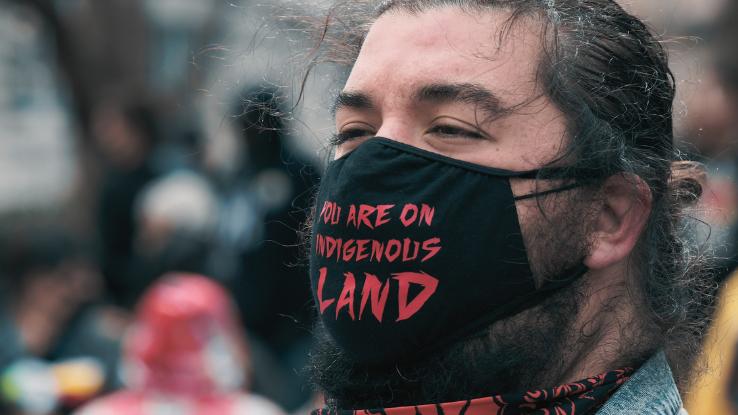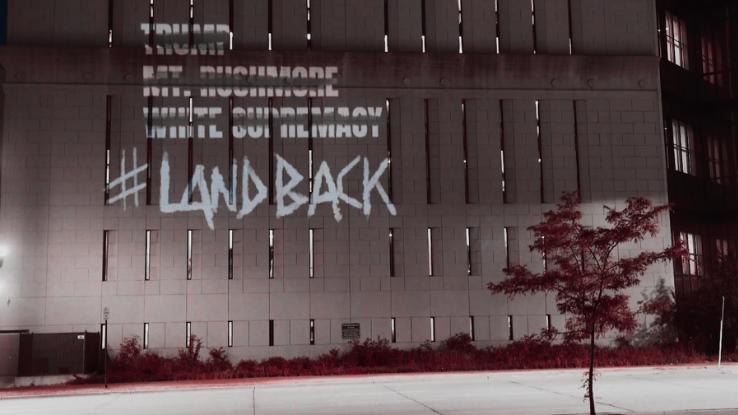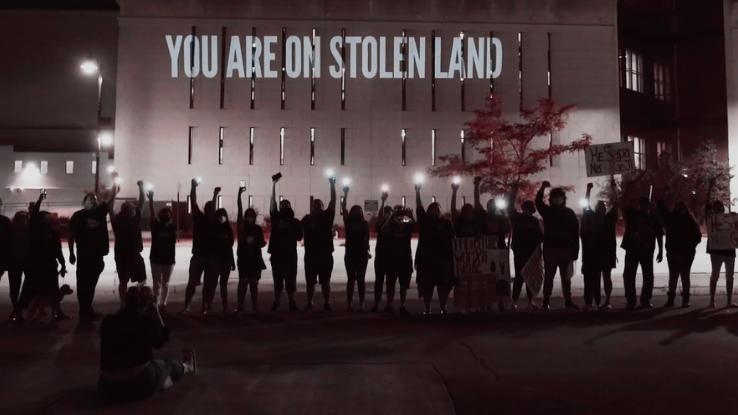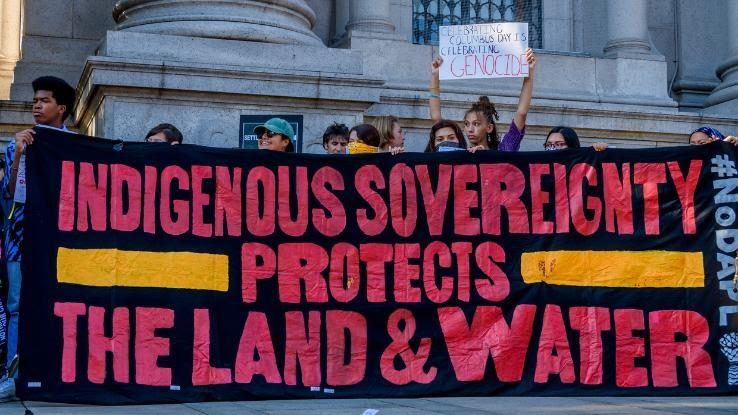
Over the last few years, you’ve no doubt read about — or supported — Indigenous-led movements that center on defending the land and protecting water rights. From the effort to Stop Line 3 to the protests at the sacred Black Hills in South Dakota, which were stolen and turned into an emblem of white supremacy and colonization, these causes share a common goal of building lasting Indigenous sovereignty.
Established generations ago, the Land Back movement, which aims to return land and resources back to Indigenous communities, is gaining more mainstream coverage. Land Back, in many ways, is at the core of other efforts to fight for climate justice and Indigenous rights and sovereignty. Here, we’ll take a closer look at the Land Back movement and why recognizing that we’re on stolen Native land — and irrevocably damaging the natural world — is a must.
What Is the Land Back Movement?
Put simply, the Land Back movement is a call for stolen Native lands to be returned to Indigenous people, who are the original stewards of said land. “‘Land Back’ is a war cry for the liberation of Indigenous people and our land,” NDN Collective CEO and president Nick Tilsen (a citizen of the Oglala Lakota nation) told Teen Vogue. “And it’s a pathway forward.”
The Land Back movement (sometimes stylized as LANDBACK) has existed for centuries. In some shape or form, it has been the aim of Indigenous activists since white European colonizers stole the land, drew up unjust treaties, and committed acts of genocide and other violence against Indigenous peoples. Today, NDN Collective, an Indigenous-led organization that’s “dedicated to building Indigenous power” via organizing, activism, philanthropy, narrative change and other means, has become a key part of the Land Back legacy. The organization not only centers Indigenous activism, but aims to create “sustainable solutions on Indigenous terms.”

Shaped by Indigenous values, NDN Collective wants a more equitable and just world for all people — a core principle that resonates with the Land Back movement, too. “LANDBACK is more than just a campaign. It is a political framework that allows us to deepen our relationships across the field of organizing movements working towards true collective liberation,” NDN Collective states on the official LANDBACK website. “It allows us to envision a world where Black, Indigenous & POC liberation co-exists. It is our political, organizing and narrative framework from which we do the work.”
Of course, colonizers and the U.S. government stole more than land, which means Land Back is more of an all-encompassing term: It’s a call to return Indigenous political sovereignty; to give Indigenous cultures, practices and beliefs the opportunity to flourish; and to ensure Indigenous people have agency over their lives and communities. Yes, it’s about returning ancestral lands to Indigenous people, but it’s also a kind of shorthand for reclamation of all kinds.
The Land Back Movement in Action
While activists involved in the Land Back movement have led many different campaigns, the moment that caught the attention of more mainstream news outlets and white Americans occurred quite recently. On July 4, 2020 — and during the COVID-19 pandemic — the former president, Donald Trump, attempted to rally support in South Dakota.
The site? The sacred Black Hills, which were desecrated and turned into what’s known by many as Mount Rushmore. Not only did the construction of this monument to racism destroy sacred lands, but the United States violated an 1868 treaty that recognized the Black Hills as part of the Great Sioux Reservation.

There, Indigenous activists, like Tilsen, made sure Trump knew he wasn’t welcome. In addition to calling for the closure of Mount Rushmore and requesting the Black Hills be returned to Indigenous people, Tilsen explained how the monument is more than just a symbol. “What Indigenous people have been saying for generations, there’s an appetite to have a conversation about symbols of white supremacy, structural racism,” he said. “Now we have to tear down these systems if we want to tear down white supremacy and structural racism in this country.”
Can such change and reclamation happen within a society defined by white supremacists? As we’ve seen with other movements, be it the Black Lives Matter movement or the fight for queer and trans liberation, the need to fight against this fundamentally bigoted and unjust system is urgent.
Ways to Support the Land Back Movement and Indigenous Activists
Returning stolen lands to their original stewards is also critically important when it comes to climate justice and working to mitigate the disastrous effects of the climate crisis. In a society that revolves around capitalism, the land and its resources are valued when there’s economic gain at stake. But it’s clear that this is a broken viewpoint that’s caused irreparable damage. Just look at the record-setting, deadly wildfires blazing up and down the Western U.S. or the unheard of heat waves melting infrastructure in the Pacific Northwest.
So, what can you do to support Indigenous communities and activists in the fight for sovereignty, justice and the return of stolen lands? In addition to educating yourself, raising awareness, amplifying the voices of Indigenous activists, and attending protests and demonstrations in person, supporting mutual aid and community-led fundraising initiatives is often the most effective way to stand in solidarity and share resources.

While individuals’ GoFundMe pages are one route of supporting mutual aid funds, there are organizations that help redistribute resources to frontline activists and communities. Some of these organizers or groups can also be supported via GoFundMe, CashApp or Venmo; these platforms are especially helpful when it comes to supporting bail funds, like the Defend O’odham Land bail fund. Other organizations have dedicated donation pages:
- Frontline Medics: Self-described as a “womn/femme-led Indigenous autonomous community medic collective.” | PayPal: wocfrontlinemedics@gmail.com; Venmo: flm-support
- Pueblo Action Alliance: Self-described as a “community-driven organization that promotes cultural sustainability by addressing environmental and social impacts in Indigenous communities.”
- Indigenous Climate Action: An Indigenous-led organization that works to support Indigenous-led climate action and climate justice.
- International Indigenous Youth Council (IIYC): Founded at Standing Rock, this group organizes youth through education, spiritual practices and civic engagement.
- Lakota People’s Law Project: Donating to this organization helps it to “support the rights and sovereignty of the Lakota people, amplify issues critical to Indigenous communities, and empower our mission for justice.”
- Water Protector Legal Collective: Self-described as a collective that provides “Indigenous-centered legal support and knowledge sharing for Earth Protectors.”
- Indigenous Kinship Collective: On the Collective’s site, it self-describes, noting, “We are a community of Indigenous womxn, femmes, and gender non conforming folx who gather on Lenni Lenape land to honor each other and our relatives through art, activism, education, and representation.”
- And, as mentioned earlier, you can directly support NDN Collective and the LANDBACK movement too.
There are countless other organizations and collectives doing essential work. Be sure to invest time into researching collectives, funds, and organizations that support your local (and, potentially, less high-profile) Indigenous-led efforts and Indigenous communities as well.
Another great resource? The Native Land Digital Map. This social learning project can tell you whose land you’re on — and we are all on Native land. The organization behind this project puts it perfectly: “Every time you share the Indigenous name for the land you are on, someone gains the opportunity for social learning and expanded curiosity for the land they are on.” In addition to learning more about whose land you’re on and sharing that knowledge with others, you can support Native Land Digital’s mission through PayPal donations or Patreon pledges.






